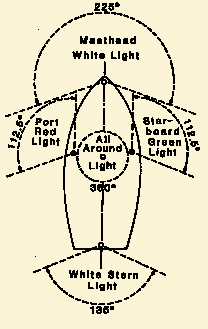Why Navigation Lights!
Just as a car or motorcycle needs lights to travel at night, so do boats.
Vehicle lights not only increase your vision of whats ahead, they allow you to be seen by others both absolutely necessary. In a boat, its being seen by others that is most critical. Chances are youve never seen your boat at night unless you were in it, so youve no idea how effective yours is.
 Before you venture out again at night, turn on all your lights and walk around the marina or slip. Youll probably be shocked at what you see (or not see.)
Before you venture out again at night, turn on all your lights and walk around the marina or slip. Youll probably be shocked at what you see (or not see.)
If others cant see you, you and your passengers are in real danger. Dont take for granted that the navigation lights installed by the manufacturer are (1) bright enough and (2) installed correctly. This is not their focus. Lights mounted incorrectly could cause you to be invisible or cause other boats to misinterpret the direction you are traveling… both disastrous situations. So, how should you go about checking your boat to be absolutely sure you can be seen at night? One good way is to see if you can read a newspaper from five feet away. If you cant, theyll do you no good.
Minimum legal requirements for small powerboats: (1980 Inland Rules, Effective 24 December 1981): Less than 39 feet must show sidelights of red (port) and green (starboard) from dead ahead to 112.5 degrees aft on each side as well as a white all-around light visible for 360o. The colored sidelights must be visible for at least one nautical mile, while the white light must be visible for two nautical miles. On most powerboats, a bi-color light on the bow combines both the sidelights into a snug fitting with one bulb and a white light mounted on a staff at the stern or on top of a radar arch or hardtop.
Our antique and classic powerboats follow the Inland Rule from the 1930s. Boats 26 feet or less use a combination red and green bow light covering 112.5 degrees (10 points) from dead ahead to both the left (red) or right (green) side of the boat. On the stern is an all- around white range light covering 360 degrees (32 points) mounted high enough to clear windshields, bimini tops, etc. On boats 26 to 65 feet there is a white bow or mast light covering 225 degrees, separated red and green side lights and an all around white forward range mast light. The side lights should be visible for one mile and the white lights visible for two miles.
Begin by making sure your lights are correctly mounted. Often the bi-color light may be aimed incorrectly so the red or green lights leak to the wrong side. Only when headed directly toward another boat should both the red and green lights be visible. Otherwise, youre giving the other boat bad information and action may be taken because of it that could jeopardize your boat.
On runabouts, the all-around light is often mounted on a post at the stern. Under ideal conditions, this may meet legal requirements, however, if you put up your Bimini top and cockpit enclosure, you may be blocking the white light from view forward.
Next, check the visibility range. Here, your concern is likely to be the colored sidelights, since the colored lenses reduce the apparent power of you bulbs. The white stern light usually provides sufficient visibility, but in many cases, you dont have to walk a mile away from your boat to know those little red and green pinpoints wont meet the one nautical mile requirement. Even if they did meet that requirement, think about the crew on the bridge of a big ship peering through a spray-encrusted pilothouse window. Can they see you and your family clearly? If you cant answer yes to all of these points, then its time to upgrade your navigation lights with those that will make you almost impossible to miss.
If yours is a bi-color light mounted on the deck at the bow, you may want to replace it with individual sidelights mounted on cabin or covering boards. This not only provides better separation, but gives additional height for easier visibility.
Consider two things when upgrading sidelights: wattage and lens. Get the most powerful bulb you can. They range from up to 25 watts for 12-volt systems with both powerful halogen and conventional filament bulbs. Lighthouses amplify the power of their lights by using fresnel (fren-nay) lenses that focus the beam. More sophisticated navigation light lenses also provide this effect. Less expensive lights rely on plain plastic lenses.
Whether youve installed new lights or are using those that came with your boat, remember to include them as part of your regular maintenance program. Always carry spare bulbs of the proper size and power. Most lights are sealed against moisture, but be sure the rubber or foam gasket is in good condition. If you see condensation inside the light, you can be sure you have a leak. Spray the electrical connection for the bulb with corrosion protection such as WD-40 or Corrosion Block. If there is a metal reflector inside the light, polish it to a shine. When underway at night, you can usually see the colored glow from each of your bow lights. If you cant, check to make sure both are working.
Remember, navigation lights are your first line of defense when using your boat at night. Make absolutely sure theyre powerful, and keep them in good condition.